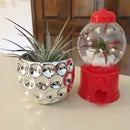Introduction: Standing Instructables Robot Box
This Instructable will teach you how to create a standing Instructables Robot box!
Be sure to not miss Steps #16-18 especially if you are the community manager reviewing this Instructable for the contests my future self will enter them in! hehe :o)
You can use this box to hide you top secret ideas for future Instructables from curious eyes (it just looks like a robot! Most people 'see that it is a box!) or if you are able to part with it, it would make a great gift for an Instructables member friend!
Hope you enjoy!
Elana
Step 1: Gather Materials
You may make equivalent substitutions for supplies if it will get the job done but here is the list of supplies I used:
1) wood pieces
-2 small rectangular plaques (front of robot's legs)
-1 small square plaque (robots head)
-12 small thin pieces of wood (to support the robots legs and help the whole robot stand up)
-2 small circle wood shapes (for the wheels)
-1 speech bubble wood shape (optional. get if you want the robot to say anything)
-a few pieces of scrap wood (we wont see it so does not matter what it looks like. We will use it to help balance the robot)
2) black sharpie (or black paint and small paint brush)
3) paint
- "light orange"
- red
-silver or gray
-white (not pictured)
-black (alternative for the black sharpie)
and paint brushes
-any brush to paint the wood pieces.
- I recommend the smallest brush you have if you aren't going to use a black sharpie for the details on the robot
4) sheet of yellow foam (from kids craft aisle of Michaels)
5) small square of red clay (for the antennae. You can also use a different color for the base and just cover the outside surface with the red. I used gray clay and covered it with red clay to make it look like it was just red)
6) a few black pipe cleaners
-2 tops for the antennae
-2 additional pipe cleaners if you choose to make speech bubble (could probably get away with one but I am saying 2 so you will be prepared)
7)paper mache box (I used a decently big one from Michaels. The smaller the box is the smaller your leg and head pieces should be in order to keep everything in proportion.)
8) Hot glue gun and hot glue sticks
*Note* I used hot glue to adhere the foam to the robot but too much hot glue melts the foam. So if it makes you more comfortable, you can use another adhesive to glue the foam to the robot such as E6000.
Step 2: Paint Time
I painted just the front and edges of the two leg plaques and head plaque. I also painted one side of 4 of the leg support pieces (the pieces that would be placed on the outside of the robots legs). You wont really see the other pieces after you put them on the robot so you don't need to paint them. I quickly painted the paper mache box. Be sure to not leave blobs of paint on the paper mache box because that will make the box form bubbles and then you will have a bumpy robot!
Pieces to not paint light orange:
-2 circle wheel pieces
-speech bubble piece
-the remaining leg support pieces (after you've painted 4 of them)
-your scrap wood pieces (they will be glued onto the back of the robot)
Next:
-paint the 2 wheel pieces silver or gray and set aside to dry
-paint the speech bubble white (if applicable)
Step 3: Create Foam Body Piece of Robot
This will cover the front of the box.
-Place box lid onto the sheet of foam (see picture for ideal placement)
-use top of box as a guide and use pen to draw an arch from one side of the foam, over the top of the box to the other edge of the foam.
-use this line to cut out the body shape
-set aside
Step 4: Turn on Hot Glue Gun and Plan
Let your hot glue gun heat up as you read the next few steps (to make sure you understand where to be gluing stuff because hot glue dries quickly and if you put a piece in the wrong stop it won't be pretty trying to fix it! (if possible at all).
Step 5: Construct Legs
use hot glue to do the following:
-glue 2 leg supporting pieces onto leg (one painted and one not) please see picture for placement (the distance between them should be equal or a little less than the width of the pieces (why? see picture #5))
make sure one of these pieces is a painted one
-glue another piece (unpainted) on the opposite edge of the leg plaque in the middle of the first two pieces
-glue another painted piece on the same side as the first painted piece you glued down. My pieces were too long to put end to end so I overlapped them and that doesn't hurt the integrity of the construction so you can do that as well!
-repeat the previous step with an unpainted piece on the other side
-glue one piece on top of the pieces you just glued but so that it is laying parallel to the leg plaque
-this leg is complete
-repeat all of the above for the other leg but make sure you put the painted leg support pieces on the opposite side of the other leg (so that when the robot is constructed, he looks painted from the side)
Step 6: Glue on Legs and Head
-put lid on box and rest it on the legs (see picture)
-we will be gluing the legs onto the BOX part of the overall box NOT the lid part of the overall box. We want to make sure that we glue the legs in a place so that we can easily take the lid on and off the box (see first picture to get an idea of how far forward the box will need to be). Feel free to make a mark in the box if you need a guidance point for where to glue the box and legs together.
-glue the head on (I put the head on at an angle but put the plaque as far back as i could while keeping the entire plaque on the box. This placement will help balance the box as opposed to putting it on the front edge of the box.)
-step back and admire your in progress robot!
Step 7: Balance Robot With Scrap Wood
I hot glued my scrap wood onto the backs of the robots legs and a low point on the robots back to help shift some of its weight backwards (so it wouldn't fall forwards).
Step 8: Details!
-preheat oven to temperature on your pack of clay
-Cut arm shapes out of foam (use picture #1 as reference)
-paint the bottom white as shown in picture #1. These will later be the robot's fingers.
-use silver or gray paint to paint 3 circles onto the robot's body. Use an image of the instructables logo if you aren't sure of the placement or see a picture above. Let dry completely.
-Use black sharpie (or black paint) to draw the button outlines and the rectangular detail under the 3 buttons. let dry if applicable.
-use black sharpie to draw line and dots on bottom of body piece (see picture #4 and #5 or image of instructables logo)
-glue foam body onto the box lid and the wheel shapes onto the bottom of the legs
Step 9: Antennae!
Use your clay to create 2 half spheres of clay. Make sure the outside of the half spheres spheres is red
(pictured is the red shell for my two half spheres. I later filled in the middle with gray clay)
Step 10: Poke Holes in Clay
Use a pipe cleaner to poke a hold in the middle of the outside of both of the half spheres.
Take out the pipe cleaner and place both clay pieces on a piece of foil on top of a baking pan
Step 11: Bake Clay for Specified Time
Bake your antennae bases at the temperature specified on the package(s) of clay and for the recommended length of time based on how thick the clay pieces are.
Take pan out of oven with oven mitt and place on a heat safe surface and let cool down completely.
Step 12: Facial Features
Use red paint to draw the red circles for eyes on the robot's face. Let dry completely.
Use sharpie (or black paint) to draw the robot's eyebrow and mouth. You can also outline the red eye circles. I wasn't patient enough to let the eyes dry all the way so I went back later and finished outlining them. (see image of Instructables logo to get an idea of how to outline it).
Step 13: Wheel Details
Use sharpie to draw line detail from logo onto the robot's legs
paint white circles on the gray wheels. Let dry completely
use sharpie to draw detail near the white circles
Step 14: Antennae Time!
place small dot of hot glue in the hole of the first antennae base and immediately place a pipe cleaner into the hole
Repeat for other antennae
Once those are dry, glue the antennae onto the robot's head
Step 15: Finishing Sharpie Details
Draw dots on the top of the arms as seen on the Instructables robot logo.
Draw the fingers onto the robot. start on the outside and work in. If you have more space than the 4 fingers require, simply cut some of the foam on inside off! Draw the lines on the robot's wrists.
Step 16: Speech Bubble! (optional)
take your painted speech bubble and write what you want on it using black sharpie or black paint. You can also outline the shape in order to help it stand out!
Step 17: Attaching Speech Bubble (if Applicable)
I used hot glue to adhere the speech bubble to the robot! Figure out what angle you want to put it at before you put glue on the robot. This will help make sure you are happy with your final placement of the speech bubble.
Step 18: DONE!
Your box is done!
Instructables- I am getting some documents scanned Monday (12/14) then I will be emailing Instructables all of my application documents.
Thank you everyone for time checking out this Instructable! Hope you enjoyed it!
Elana

Participated in the
Homemade Gifts Contest 2015

Participated in the
Robotics Contest











